The Eugenics Movement in North Carolina
Document Presets
To download, choose the "Save as PDF" option when asked to choose a printer.
Primary Source Set
The Eugenics Movement in North Carolina
Between 1929 and 1974, over 7,600 people were sterilized, or made unable to have children, in North Carolina. Sterilization was a key part of eugenics, a theory and movement that claimed it could improve humankind through selective breeding. Through sterilization, North Carolina restricted the fertility of individuals that were considered “undesirable.” Many were forced or coerced into sterilization. This primary source set uses newspaper articles, newspaper advertisements, and a bulletin to illustrate the effects of sterilization, eugenic ideas, and eugenic legislation in North Carolina.
Proceed with caution and care through these materials as the content may be disturbing or difficult to review. Many primary sources in this set use eugenicist ideas to support the discrimination of non-white people and people with mental illness or mental disability. Please read DigitalNC’s Harmful Content statement for further guidance.
Time Period
1912-2014
Selected Sources
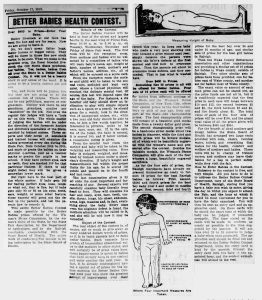
"Better Babies Health Contest," The Smithfield Herald
Smithfield, N.C. (Johnston County), 1970
During the early 20th century, state fairs across the country held “Better Babies” contests, where infants were inspected by physicians and nurses and then judged on various physical and mental qualities. According to this article from The Smithfield Herald, which promotes and provides information on a Better Babies contest at Raleigh’s state fair, winners of the event received a medal and a cash prize. The article claims that the contest was to teach parents how to improve their children’s health. However, Better Babies contests were closely tied to eugenics, as they encouraged parents to “improve” bloodlines and create “better” humans.
Contributed to DigitalNC by Johnston County Heritage Center, University of North Carolina at Chapel Hill
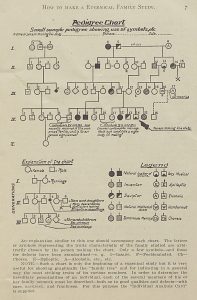
Sybil Hyatt's Eugenics Field Work
Kinston, N.C. (Lenoir County), 1970
Sybil Hyatt’s Eugenics Field Work includes a bulletin on how to create a eugenical family study. The page shown here is an example of a pedigree chart, or eugenic chart, which outlines a family tree and describes the families’ “good qualities” and “defects.” Charts like these encouraged selective breeding and promoted the idea that individuals with certain traits are less fit to reproduce. This page emphasizes the importance of describing a person’s traits to determine “hereditary potentialities.”
Contributed to DigitalNC by Neuse Regional Library, Kinston-Lenoir County Public Library
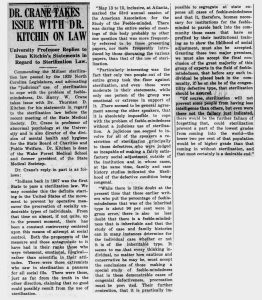
"Dr. Crane Takes Issue with Dr. Kitchin on Law," The Daily Tar Heel
Chapel Hill, N.C. (Orange County), 1929
This article from The Daily Tar Heel describes a university professor’s response to a medical school dean’s view on sterilization. In particular, it shares his view on the 1929 sterilization law passed by the North Carolina General Assembly. This law allowed the state’s charitable and penal institutions to sterilize patients and inmates when deemed necessary by the institution’s head. In his response, the professor discusses the controversy surrounding sterilization. He also provides his own reasons for supporting the “judicious use” of the procedure.
Contributed to DigitalNC by University of North Carolina at Chapel Hill

"Sterilization Is Best Cure For Mental Disease," The News-Journal
Raeford, N.C. (Hoke County), 1945
In this article from The News-Journal, author Evangeline Davis argues in favor of sterilization procedures for people with mental illnesses. Davis reportedly completed sterilization research for the North Carolina Mental Hygiene Society. She provides an overview of eugenics-related legislation in the state and claims that sterilization is “the answer to the problem of the growing rate of mental disease and deficiency.”
Contributed to DigitalNC by University of North Carolina at Chapel Hill, Hoke County Public Library
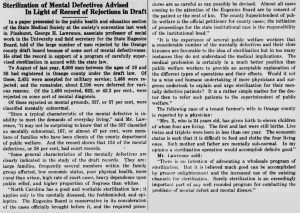
"Sterilization of Mental Defectives Advised In Light of Record of Rejections in Draft," The Chapel Hill Weekly
Chapel Hill, N.C. (Orange County), 1946
Before and during World War II, hundreds of thousands of North Carolina men were drafted to fight in the conflict. While many men were subject to the draft, some individuals were rejected due to various reasons, including “mental defectiveness.” This 1946 article from The Chapel Hill Weekly provides the statistics of draft rejections in Orange County. It then uses these statistics to argue for sterilizing “the mentally diseased, the feebleminded, and epileptics.”
Contributed to DigitalNC by University of North Carolina at Chapel Hill
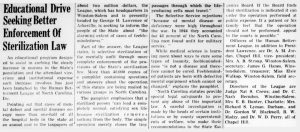
"Educational Drive Seeking Better Enforcement Of Sterilization Law," The Cherokee Scout
Murphy, N.C. (Cherokee County), 1947
This Cherokee Scout article reports on an educational program dedicated to better enforcing North Carolina’s sterilization law. Led by the state’s Human Betterment League, the program sought to inform more people about selective sterilization through distributing pamphlets with information about the procedure. The article includes several quotes from the pamphlets, all of which maintain a supportive viewpoint on sterilization.
Contributed to DigitalNC by Murphy Public Library, Nantahala Regional Library, University of North Carolina at Chapel Hill

"Selective Sterilization Advisable," The Marion Progress
Marion, N.C. (McDowell County), 1949
This article from The Marion Progress promotes North Carolina’s selective sterilization program. It claims that the program saved the state almost six million dollars by preventing the birth of children through sterilization. Additionally, the article argues that sterilization protects society against the “burden” of children of “mentally-abnormal” parents.
Contributed to DigitalNC by McDowell County Public Library, University of North Carolina at Chapel Hill
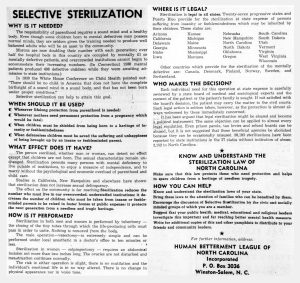
"Selective Sterilization," The Daily Tar Heel
Chapel Hill, N.C. (Orange County), 1949
Created in 1947, the Human Betterment League was a group dedicated to advocating for sterilization through media. In this issue of The Daily Tar Heel, an advertisement from the League promotes and provides information about selective sterilization and sterilization laws in North Carolina using a question-and-answer format. The advertisement emphasizes its claim that sterilization is a safe procedure that protects children from being born to “insane or feebleminded parents.” It also encourages readers to discuss the “benefits” of selective sterilization with their communities.
Contributed to DigitalNC by University of North Carolina at Chapel Hill

"State Sets Record For Sterilizations," The Chowan Herald
Edenton, N.C. (Chowan County), 1951
This article from The Chowan Herald discusses the number of sterilizations performed in North Carolina during February of 1951. According to the article, the State Eugenics Board authorized a total of 42 sterilizations in that month, which set a new record for the Board.
Contributed to DigitalNC by Shepard-Pruden Memorial Library, Pettigrew Regional Library
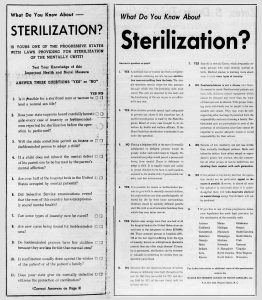
"What Do You Know About – Sterilization?," The Daily Tar Heel
Chapel Hill, N.C. (Orange County), 1951
In this second advertisement from the Human Betterment League, readers are prompted to test their knowledge about sterilization by answering eleven “yes” or “no” questions about the topic. On a later page, the League provides their correct answers to and explanations for each question. They stress that sterilization is a safe, legal, and necessary procedure to “protect” people with mental illness or “feeblemindedness” from becoming parents.
Contributed to DigitalNC by University of North Carolina at Chapel Hill
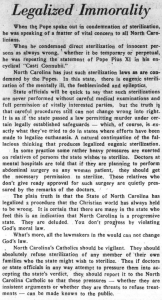
"Legalized Immorality," The North Carolina Catholic
North Carolina, 1953
While North Carolina legitimized sterilization through legislation, not all of the state’s citizens approved of the procedure. At the height of sterilization’s popularity, Catholic communities in the state often spoke out against it due to their religious beliefs. This article from The North Carolina Catholic denounces sterilization. Additionally, it calls the procedure a moral wrong and criticizes how doctors pressured some people into sterilization.
Contributed to DigitalNC by Catholic Diocese of Raleigh
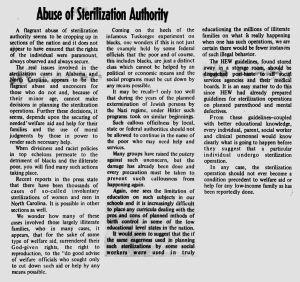
"Abuse of Sterilization Authority," The Carolina Times
Durham, N.C. (Durham County), 1973
During the 1970s, criticism directed toward sterilization increased. This article from The Carolina Times discusses an abuse of sterilization authority. It also states that poor minority communities may be unfairly affected by forced sterilizations. The article suggests that, to combat this issue, education on what sterilization entails must be increased and improved.
Contributed to DigitalNC by Durham County Library, State Archives of North Carolina, University of North Carolina at Chapel Hill

"Report tries to make amends," The Winston-Salem Chronicle
Winston-Salem, N.C. (Forsyth County), 2003
After Governor Michael Easley established a Eugenics Study Committee in late 2002, the Committee produced a set of recommendations meant to support eugenics victims. This article from The Winston-Salem Chronicle describes the recommendations, which include the creation of a foundation or support group, education programs, and a health care fund.
Contributed to DigitalNC by Forsyth County Public Library, University of North Carolina at Chapel Hill

"Eugenics victim tells her story," The Perquimans Weekly
Hertford, N.C. (Perquimans County), 2011
This article from The Perquimans Weekly discusses a plan to provide compensation for the thousands of individuals who were forcibly sterilized in North Carolina. A public hearing on sterilization was led by a Eugenics Task Force, who worked to determine the amount of money that affected individuals would receive. Additionally, the article includes several quotes from Elaine Riddick, a woman who was forcibly sterilized in North Carolina when she was 14 years old.
Contributed to DigitalNC by Perquimans County Library, Pettigrew Regional Library
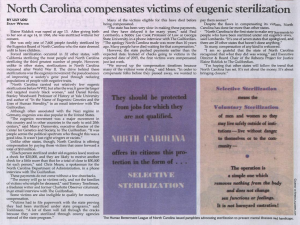
"North Carolina compensates victim of eugenic sterilization," The Guilfordian
Greensboro, N.C. (Guilford County), 2014
In 2010, North Carolina Governor Beverly Perdue established the Justice for Sterilization Victims Foundation. After the state’s Eugenics Task Force determined the amount of compensation to give victims, the Foundation began to promote the compensation program across North Carolina. This article from The Guilfordian discusses the program and states that eligible individuals received at least $20,000 from a pool of $10 million. However, the article also acknowledges some of the drawbacks of the compensation program, like the fact that many sterilization victims had already died by the time the program was enacted. Moreover, only individuals who were sterilized by the state could receive payment; people who were sterilized by other groups were unable to receive compensation.
Contributed to DigitalNC by Guilford College
Background
First proposed by Sir Francis Galton in 1883, eugenics claims humankind can improve through selectively breeding for traits that are considered desirable or superior. Although eugenics is scientifically incorrect and unethical, the early to mid-twentieth century saw the eugenics movement gain widespread popularity across the United States, including North Carolina. From 1929 to the late 1970s, North Carolina upheld and validated the eugenics movement through legislation and public promotion of sterilization.
Sterilization procedures allowed North Carolina to restrict or eliminate the fertility of people who were considered “undesirable.” Some examples of “undesirable” people included individuals with mental disabilities. In the articles and advertisements in this set, these individuals are often referred to as “feebleminded” and “mentally defective.” Eugenics supporters believed that the children of such people could inherit their “inferior” traits, causing a “burden” on the parents, the public, and the state. By sterilizing people, they thought the burden could be alleviated. While sterilization was aimed at people with disabilities, the procedure was also used extensively on non-white people or people whose sexual or social behavior was considered “defective.” Selective sterilization groups like the Human Betterment League claimed that the procedure was done with the consent of the patient or their family. However, many individuals were forced or coerced into sterilization.
In 1929, the General Assembly passed a law that permitted the sterilization of individuals held in any charitable or penal institutions in North Carolina when the sterilization was determined to be the best course of action for the individual or for the public good. In 1933, the General Assembly established the North Carolina Eugenics Board. Made up of five state government members, the Eugenics Board was responsible for reviewing and approving all sterilization procedures in North Carolina. In 1937, Assembly members passed another act that permitted state hospitals to temporarily admit and sterilize people who had been approved for the procedure by the Eugenics Board. While sterilization and eugenics were normalized and embraced in North Carolina during the early to mid-20th century, the 1970s saw public criticism rise. After a name change from the Eugenics Board to the Eugenics Commission in 1973, the group was abolished by the General Assembly in 1977.
In 2002, Governor Michael Easley made an official declaration to victims of forced or coerced sterilization. He apologized for the role that the North Carolina government had played in supporting and promoting selective sterilization. Easley also established a Eugenics Study Committee. In 2003, he repealed legislation that still made sterilization legal in the state. In a report made by the Eugenics Study Committee, members stated their belief that North Carolina should provide financial compensation to victims. Representative Larry Womble, who was part of the committee, later introduced a bill to give a sum of money to those affected by forced sterilization. However, it was not until 2010, when the Office of Justice for Sterilization Victims was created, that a compensation plan was put in place. By 2014, eligible individuals who made a claim to the Office received $20,000 or more as payment. Some have called the program flawed, as many victims were thought to have died by the time it was created. Moreover, only individuals whose sterilizations were approved by the Eugenics Board could file a claim; others who were sterilized under a different authority’s mandate were not able to receive compensation from the Office.
Discussion Questions
Consider the first and second newspaper advertisement from the Human Betterment League. How do they describe the consequences of not sterilizing “feebleminded” and “mentally deficient” individuals? What tactics do they use to defend and justify sterilization procedures?
Many of the primary sources in this set are newspaper articles or advertisements that promote selective sterilization to the public. How did mass media–like newspapers–influence the North Carolina public’s perspective on eugenics and sterilization?
From the early to mid-twentieth century, selective sterilization was normalized and even encouraged in North Carolina. What factors contributed to the normalization and general support of sterilization?
While the North Carolina government eventually established a compensation initiative for forced sterilization victims in 2010 and began payments in 2014, many have pointed out the flaws in the initiative. What are some of the issues in the compensation program, and what could the North Carolina government have done to better support victims of forced sterilization? Is there anything North Carolina can do today?
Consider the viewpoints in The Carolina Times article, The North Carolina Catholic article, and The News-Journal article. What different perspectives do you notice in each piece? How does criticism of sterilization in The Carolina Times article differ from that in The North Carolina Catholic piece?
Take a look at the article from The Smithfield Herald, making sure to notice the ways in which “better babies” are described. How does the “Better Babies Health Contest” connect to other eugenicist concepts, like selective sterilization?
These materials were compiled by Isabella Walker. Updated March 2025.
https://www.digitalnc.org/primary-source-sets/the-eugenics-movement-in-north-carolina/
This document was prepared for print on September 18, 2025.